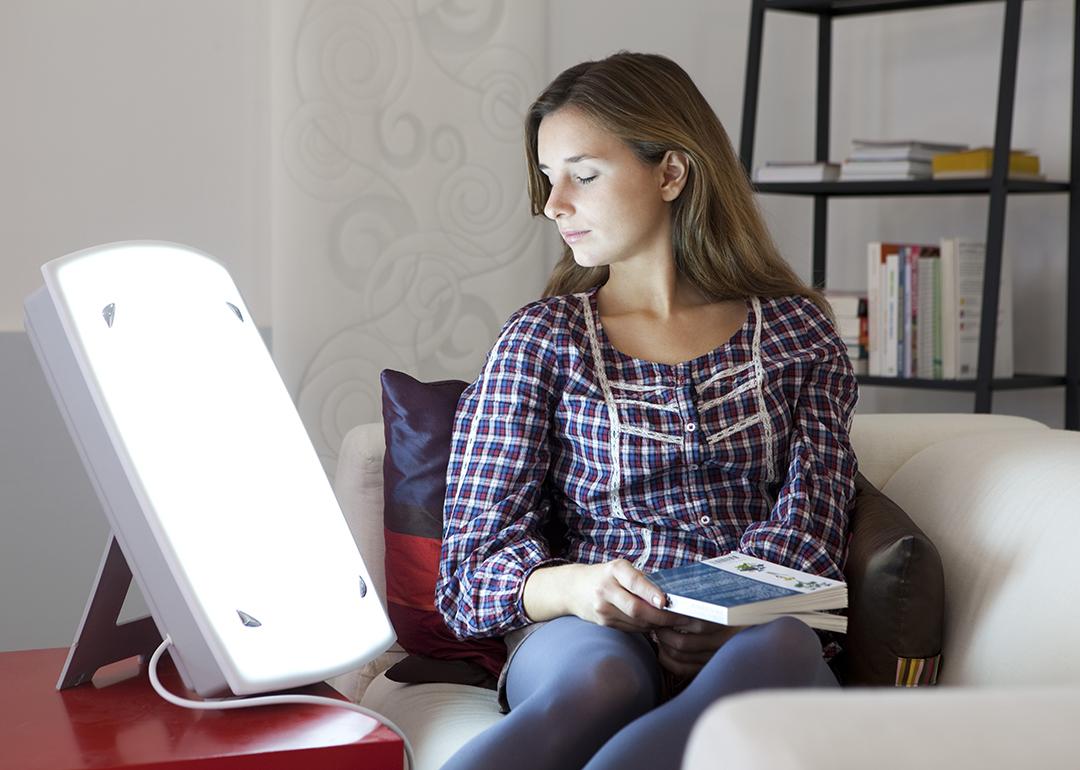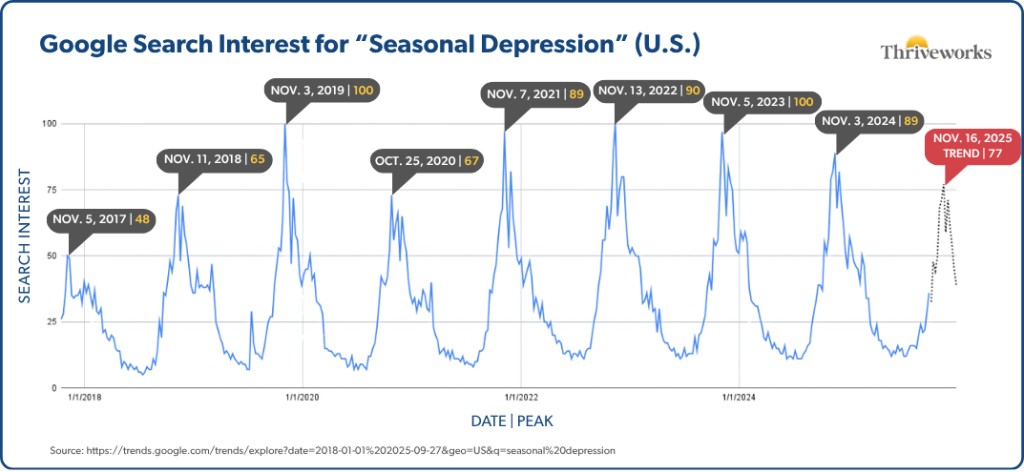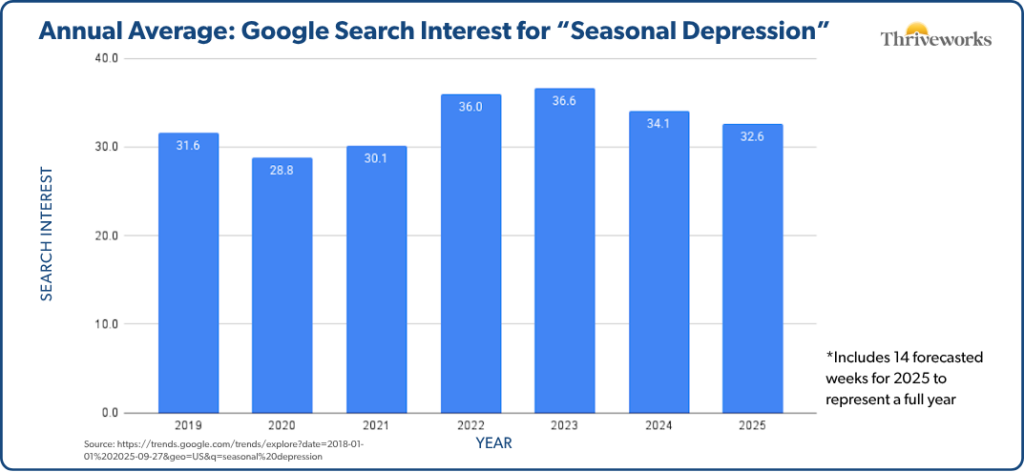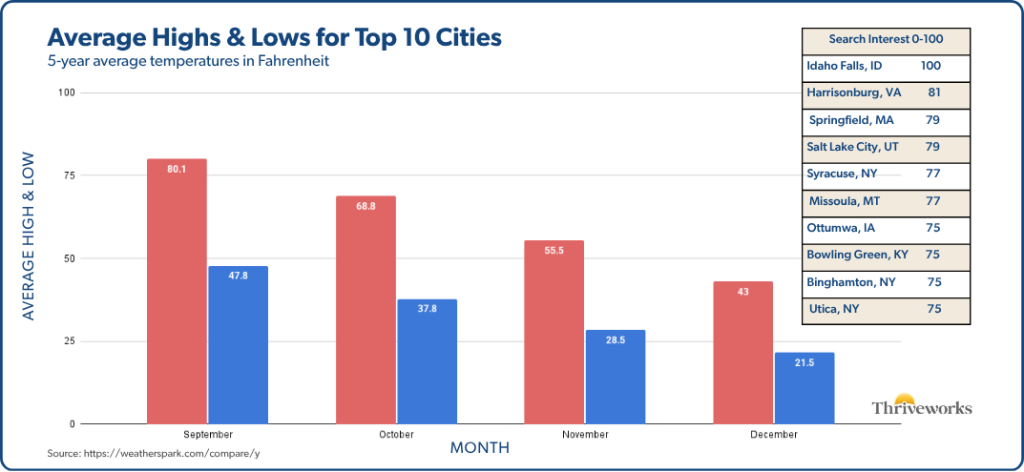
The 10 US cities where seasonal depression hits hardest (and when it peaks this year)
The 10 US cities where seasonal depression hits hardest (and when it peaks this year)
We can predict flu season. We know when cold and allergy meds will fly off the shelves. So why not seasonal depression? For the fourth year, Thriveworks has analyzed Google search trends and weather data to pinpoint when seasonal depression hits hardest, giving people a chance to get ahead of it with preventative care or treatment.
This year, the pattern is holding: Seasonal depression is expected to peak in the third week of November. That’s when searches for seasonal depression historically spike. And true to form, search interest already climbed 125% from mid-August to late September (Aug. 10-Sept. 28)—the typical seasonal ramp-up as days get shorter and temperatures drop.
What Is Seasonal Depression?
Before diving into the research, let’s clarify what seasonal depression means. Officially, it’s called seasonal affective disorder (SAD), and it’s a type of depression that follows a seasonal pattern.
“Seasonal depression describes episodes of major depressive disorder that occur at a specific time of year—most commonly fall and winter,” explains Laura Harris, a licensed clinical mental health counselor at Thriveworks. “The key characteristic is that symptoms appear during a particular season and then resolve when that season ends.”
Common Symptoms to Watch For
Symptoms of seasonal depression match those of other types of depression. These include:
- Reduced interest in day-to-day life
- General discontent
- Being withdrawn
- Feeling hopeless
- Difficulty concentrating
- Loneliness and isolation
- Difficulty sleeping
- Fatigue
- Changes in appetite
To meet the diagnostic criteria for seasonal depression, symptoms must resolve at the end of the seasonal period. For example, someone might develop symptoms at the beginning of fall and then see them conclude at the start of spring. They must also experience this seasonal depressive pattern for at least two years.
When Does Seasonal Depression Peak?
The goal was to understand exactly when seasonal depression might reach its peak this year to better help those who suffer from it.
“By knowing how seasonal triggers affect you and when they typically hit, you can plan ahead,” says Heidi Faust, a licensed clinical social worker.
The strategy? Get more done during your good months, and set yourself up for success during the hard ones. “This might mean scheduling important appointments with reminders during the fall and winter months—things like annual checkups or therapy sessions,” Faust explains. “You can also build in activities that help counter seasonal depression, like regular social plans or outdoor time.”
Google search data for “seasonal depression” over the last five years (U.S. searches only) was analyzed to predict this year’s peak. The pattern is consistent: Searches spike in mid-November, year after year.

Is Seasonal Depression Getting Worse?
Researchers conducted a comparison of the eight-week time period from Aug. 10 to Sept. 28 for “seasonal depression” search data for the last six years to gain insights into this year’s peak.
Over the past six years, there has been steady growth in search interest for the term “seasonal depression,” indicative of expanded awareness of the affliction. Between the years of 2019 and 2025, search interest for this topic has grown at an average annual rate of 7%.
A comparison of the eight-week buildup period revealed that search interest in seasonal depression followed its typical seasonal pattern, increasing 125% from mid-August to late September as fall approached.

The Connection Between Temperature Drops and Seasonal Depression
This year’s Google Trends analysis also showed where search interest for “seasonal depression” was the highest over the last five years. The top 10 metros are geographically diverse but share a common thread: dramatic temperature shifts in the fall.
The 10 U.S. Cities Where Seasonal Depression Hits Hardest
- Idaho Falls, Idaho
- Harrisonburg, Virginia
- Springfield, Massachusetts
- Salt Lake City, Utah
- Syracuse, New York
- Missoula, Montana
- Ottumwa, Iowa
- Bowling Green, Kentucky
- Binghamton, New York
- Utica, New York
We then looked at weather data, including average monthly temperatures, for these 10 metros. The team discovered that throughout the months of September, October, November, and December—when seasonal depression tends to peak—these top 10 cities experience an average temperature drop of 27.95 degrees.

This aligns with the Google Trends research, showing that search interest peaks between October and November with consistently high search volume through mid-December. The data suggests that rapid seasonal changes—both temperature drops and decreasing daylight hours—drive the spike. Most of these top 10 cities are in the northern U.S., where fall brings both dramatic temperature shifts and significant daylight loss, which together contribute to seasonal depression symptoms.
What Actually Helps With Seasonal Depression
Kate Hanselman, a board-certified psychiatric nurse practitioner at Thriveworks, recommends a few actions that can help you manage symptoms of depression during seasonal changes.
Start With Environmental Changes
- Use a light therapy box first thing in the morning. Aim for 20-30 minutes of light exposure within the first hour of waking up. Position the lightbox at eye level, about 16-24 inches from your face, while you have breakfast or check email. Morning light exposure helps reset your circadian rhythm and supports serotonin production.
- Get outside before noon, even on cloudy days. Natural daylight—even through clouds—is significantly brighter than indoor lighting and helps regulate melatonin production. A 15-minute morning walk exposes you to light that indoor environments simply can’t replicate.
Build Daily Habits That Protect Your Mood
- Wake up at the same time every day—yes, even weekends. Your circadian rhythm controls serotonin production, and inconsistent wake times disrupt this system. A stable wake time naturally regulates your sleep-wake cycle within two to three weeks, even if your bedtime varies. Rising at the same time every day can naturally stabilize a variable bedtime.
- Move your body in ways that feel good. Whether it’s a YouTube yoga class, a walk with the dogs, joining a fitness class, or taking the stairs, it all counts. Physical activity supports mood regulation, but the key is consistency over intensity.
- Connect with people daily, even in small ways. Seasonal depression often comes with the urge to isolate, which can worsen symptoms. Daily social contact—whether it’s dinner with family, helping a neighbor, or simply a text to friends—helps counter the loneliness-depression cycle.
- Limit alcohol and other substances. While it can be tempting to think that a drink or two will ease your distress, substance use typically worsens existing depression symptoms. If you use substances regularly, check with a professional before stopping on your own to make sure you have the support you need.
When Symptoms Hit, Use These Tools
- Get it down on paper. Journaling helps you externalize what’s happening internally, making patterns more visible and feelings more manageable. Planning out your week on a calendar and scheduling at least one enjoyable activity daily can also help reduce overwhelm and increase joy. And if you’re overwhelmed by tasks, try writing a to-do list and crossing off one to two things daily.
- Build a coping tools box. Fill it with things that help ground you: photos of happy times, a favorite playlist, a list of grounding techniques, a plan for gentle movement, or a coloring book. Having these tools ready makes them easier to reach for when you need them most.
When to See a Therapist for Seasonal Depression
In addition to practicing the above strategies, it’s important to seek professional help. “Come see us,” says Hanselman. “Meet with a mental health provider to discuss what options are available to make your symptoms more manageable, whether that’s medication, therapy, or a combination of both.”
Cognitive behavioral therapy is an evidence-based approach to treating depression. Within this modality, clients are taught to identify and change unhelpful thoughts and behaviors. The role of the therapist is to teach skills that help positively align the relationship between thoughts, feelings, and behaviors.
If you’re experiencing symptoms of seasonal depression, please reach out for help.
This story was produced by Thriveworks and reviewed and distributed by Stacker.



